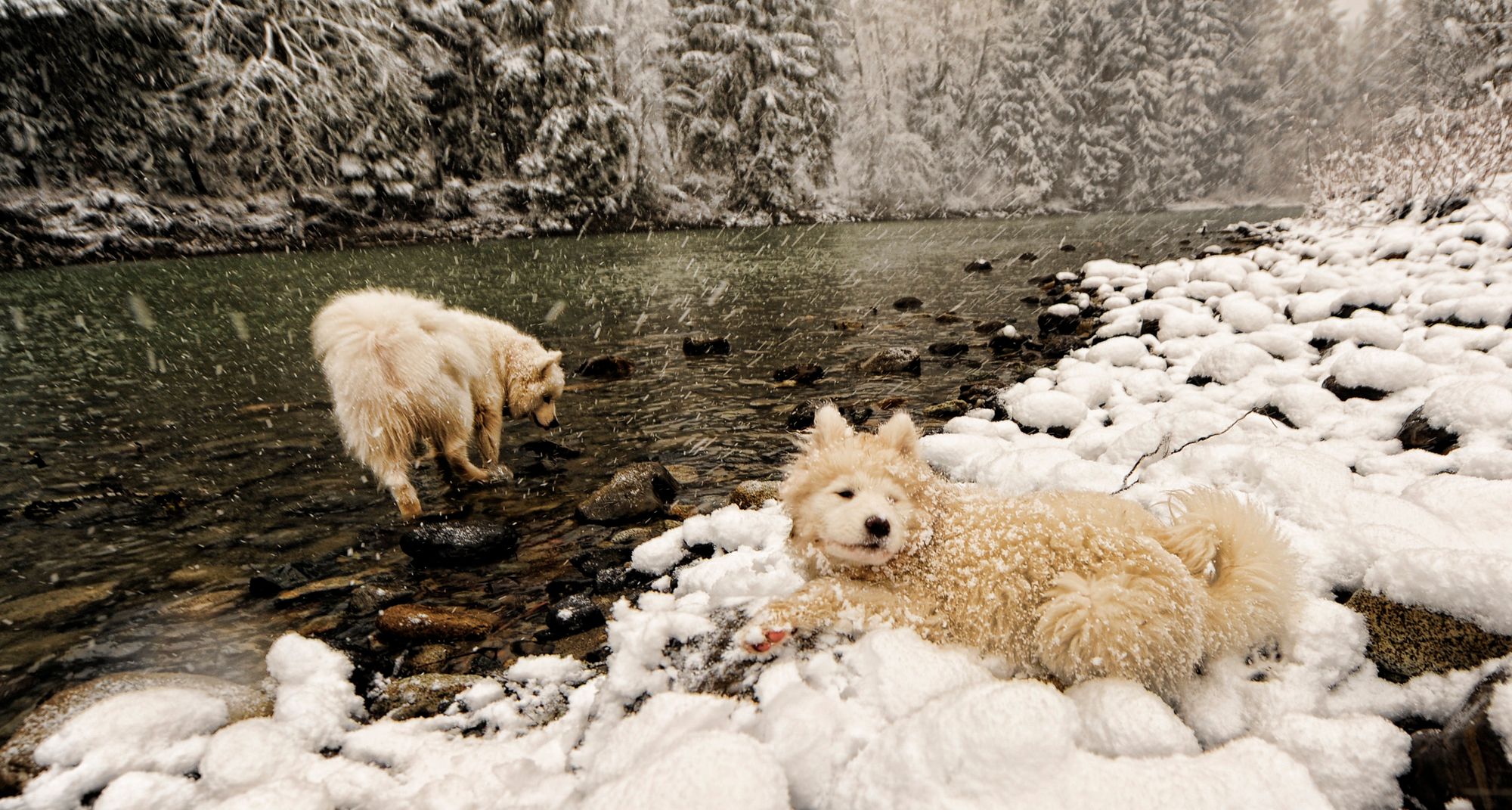Being Jamie
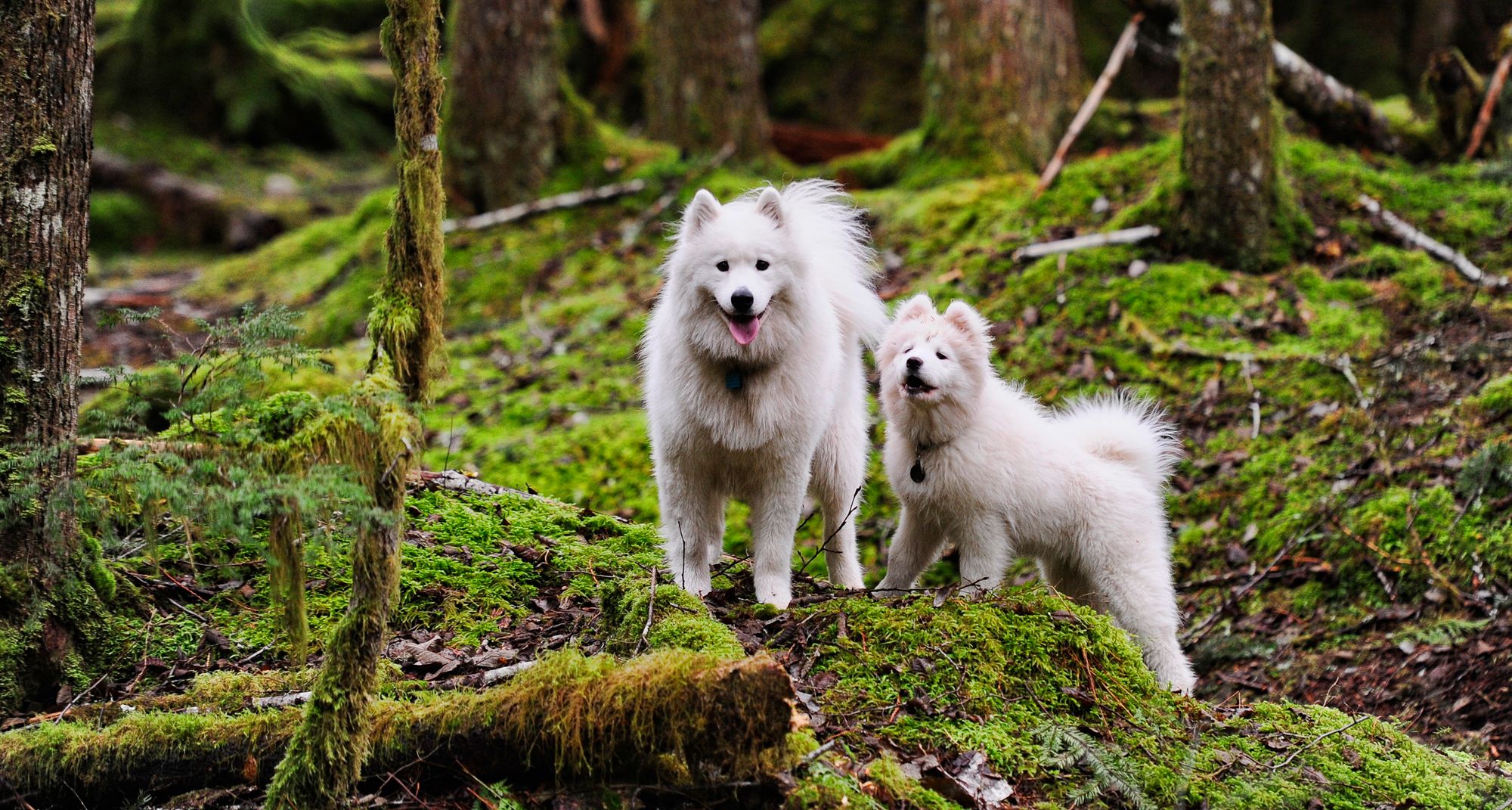
This is a post from the past: a blog post we published in 2010 that got deleted when this blog was migrated to a different platform in 2015. I've recovered the text from a backup, and added a few photos from the month when it was originally posted, as well as a few links to other posts I've written in the years since which expand on some of the things mentioned here.
At the time of this post, Jamie had been with us 11 months, and Alice just 2 months. Jamie had just surpassed 200 followers on Facebook, and the original point of the post was how "being Jamie" had become my primary online activity over the previous year, but it sort of morphed into an introduction to Jamie's personality for those who didn't know him well. It's more about Jamie's personality than Alice's, because she was still a tiny pup and we didn't know her as well yet.
There are some aspects of this post that are interesting to me in hindsight. For example, in reading this for the first time in many years, I was struck by how it foreshadows Alice's stick-in-the-neck adventure. And there are references to things like Jamie's Twitter page, which has been inactive for years, or Megan posting as Jamie, which she hasn't done in years. Even the core premise – posting "as" Jamie – is no longer true now that Jamie is gone. But there are observations here about Jamie and Alice's personalities that still rung true, and became even more clear in the years after this post.
If you've started following Jamie's page in recent years, this is a glimpse of how it started. And if you've been along for the ride ever since those days, this is a reminder of that innocent time before Alice earned her "Air Alice" nickname, when both Jamie and Alice were still pups and we were all just getting to know them.
December 26, 2010 – 11:34PM
This got rather long, and I decided to just leave it that long and post it. If you’re one of those people who think about Jamie and Alice every day, you might make it through the whole thing. If not, that’s OK.
I’ve been posting my photos, opinions and experiences online since the mid-90s, and I’ve usually marked the end of the calendar year with a post recapping some of my favorites. But looking back on 2010, I realize that I’ve really not done much blogging (or Twittering or Flickring, etc.) as myself. Oh, I’ve posted pretty much every day, sometimes many times in a day, but most of my online presence this year has been the things I’ve posted “as a dog.” As my work-related social media activities have scaled back for various reasons, my canine activities have more than filled the gap.
In January, Megan and I started posting to Twitter "as" our new puppy Jamie, an 8 week-old Samoyed. Then a couple of months later, at the urging of Jamie’s online friends Jen and Evonne, we started posting photos of Jamie to Facebook, having created a “public figure” page for one Jamie Samoyed. A few months after that, when a few of my Flickr friends commented on the increasingly puppy-dominated nature of my photostream, I created a Dogerino Flickr account just for puppy photos, in addition to the Dougerino account I use for everything else.
I’ve posted to these sites hundreds of times this year. Over time, the Jamie Samoyed page on Facebook has become the main outlet for photos of the dogs, with links to those posts appearing on Twitter (automatically), and a manually selected subset (plus a few others) appearing on the Dogerino photostream on Flickr. Megan and I sometimes appear in the photos, but the vast majority are simply photos of the dogs being dogs.
So to mark the end of 2010, I thought I’d share some background info about how we came to have two dogs this year and what it’s like to be their social media staff. The pay is low and the hours are long, but if you’re wired like me, it’s a dream job.
Samoyeds
Jamie and Alice are Samoyeds, a sled dog breed from Siberia. I’ve loved sled dogs ever since I was a 12 year-old paper boy and my paper delivery route included a house with two Alaskan Malamutes. I had a Collie named Kingo who often came with me on my route, and those Malamutes seemed to be all the things I loved about Kingo – big, strong, smart, playful, fearless – but perhaps even more so.
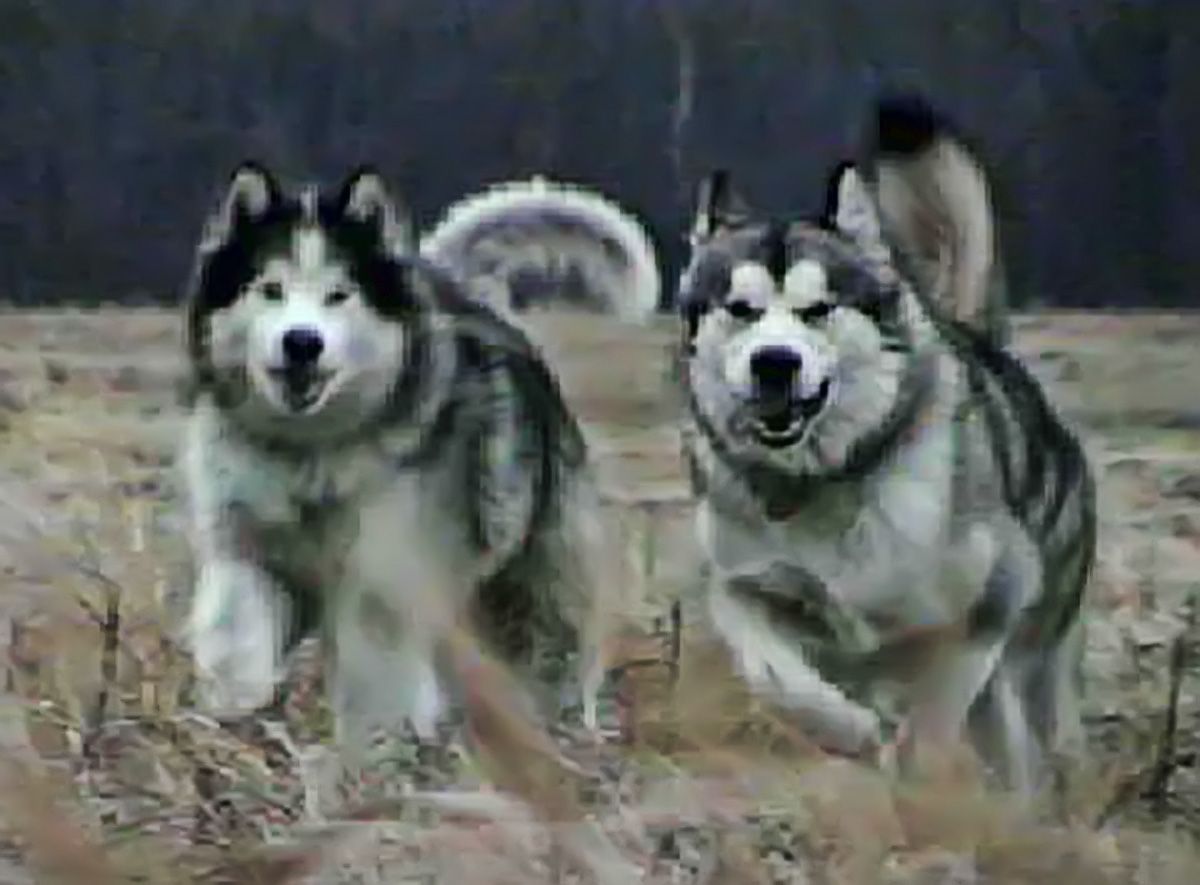
Later in life, I had the pleasure of living with two wonderful Malamutes, Mia and Trouble. But before Mia, my first dog as an adult was a Samoyed named Rex. He was an impulse purchase (from a relative with puppies for sale), and I quickly fell in love with the breed. I still have a strong preference for sled dogs over other breeds (perhaps because of my lifelong fascination with wolves and coyotes, which are similar in some ways), but I’ve definitely settled on Samoyeds as my favorite. Rex had a wonderful ability and desire to understand people and interact with them, and I found his combination of sled-dog toughness and teddy-bear cuddliness irresistibly appealing.
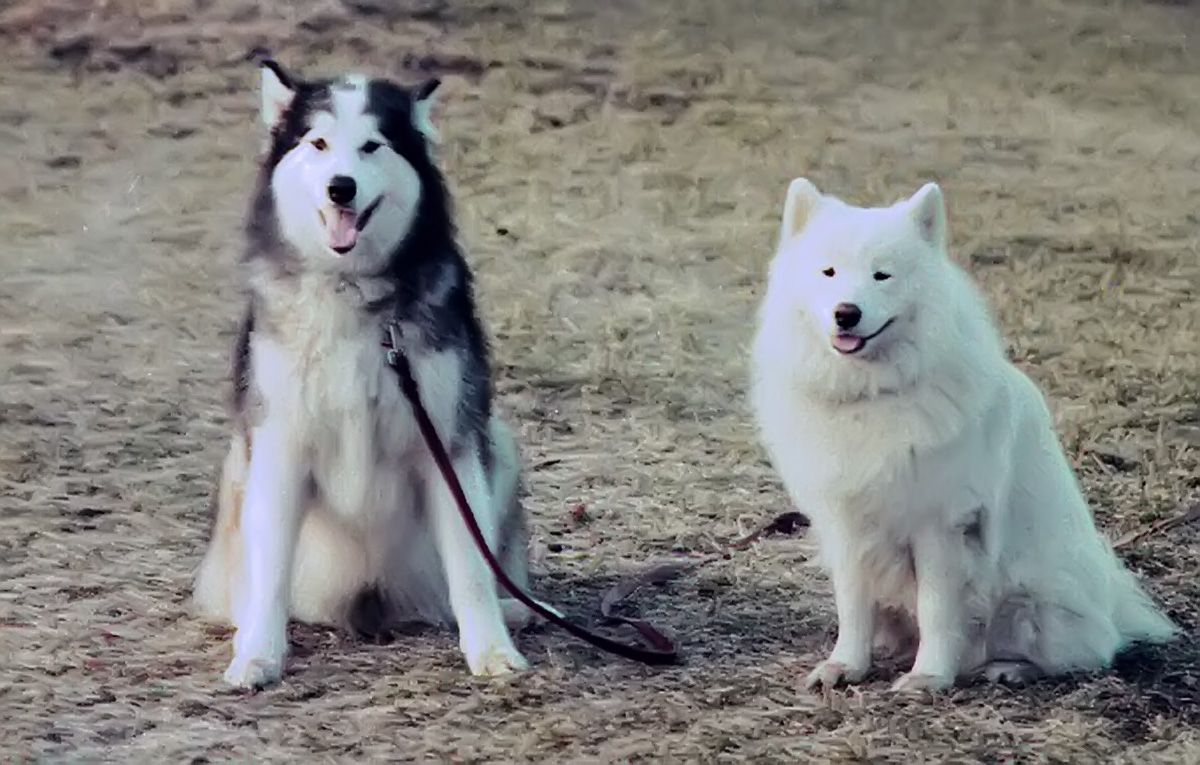
The official AKC page on Samoyeds says this about the breed:
An ancient working breed, the Samoyed is very close to the primitive dog – no mixture of wolf or fox runs through the breed’s gene pool. He was developed by the Samoyede people of Siberia. They used the dogs for herding reindeer, hunting and hauling sledges as well as guard work. The breed was cherished by these people – they even allowed them to sleep in their tents – because they depended on the dogs for their survival.
Intelligent, gentle and loyal, Samoyeds enjoy being with their families. Due to their working heritage, they may chase things, run and bark, so it’s best to channel that energy into some kind of job or activity. Otherwise, these independent thinkers may invent ways to keep themselves entertained. At the very least, daily exercise is necessary. The Samoyed coat can also mat and needs to be brushed weekly, more often during shedding season.
And Wikipedia describes Samoyeds this way:
Samoyeds' friendly disposition makes them poor guard dogs; an aggressive Samoyed is rare. With their tendency to bark, however, they can be diligent watch dogs, barking whenever something approaches their territory. Samoyeds are excellent companions, especially for small children or even other dogs, and they remain playful into old age. When Samoyeds become bored they may begin to dig. With their sled dog heritage, a Samoyed is not averse to pulling things, and an untrained Samoyed has no problem pulling its owner on a leash rather than walking alongside. Samoyeds were also used to herd reindeer. They will instinctively act as herd dogs, and when playing with children, especially, will often attempt to turn and move them in a different direction. The breed is characterized by an alert and happy expression which has earned the nicknames "Sammy smile" and "smiley dog."
Rex was all of those things. He could fill a room with positive energy, and I don’t recall him ever being in a bad mood. As a puppy, he once pulled an entire bag of puppy treats off the kitchen counter and gleefully carried them to me at my desk, as if to say “look what I found!” He learned many phrases that we didn’t even intend to teach him, and it says something about my eating habits at the time that he knew the words “pizza” and “beer” so well. I was an avid golfer, and we spent long hours in the back yard practicing, with him catching chipped golf balls by the dozen but never once returning any of them to me.
We got Mia a few months after Rex, and when the two of them grew bored, they would chew on the furniture. They destroyed a couch as well as my favorite padded easy chair, which looked like a bomb had blown up inside it by the time they were done. We replaced those items with sturdier sled-dog-ready furniture, and now the corners of that furniture have Jamie and Alice’s chew marks on top of Rex and Mia’s. I can’t imagine ever repairing those chew marks – it makes me happy to see them, every day.
We lost Rex suddenly to a rare strain of viral encephalitis when he was five years old in 1995. He went from a happy, healthy, high-energy dog to a comatose state in a matter of days, and it seemed brutally unfair to him, and to everyone who loved him. I’ve lost several dogs I’ve been very close to before, and have known many other dogs under various circumstances, but nothing ever devastated me like losing Rex. I remember realizing late one evening, a few weeks after his death, that I hadn’t shed a tear about him all day long, and the realization that the pain was fading kept the tear-shedding streak alive. I hated the summer of 1995, when the sun was too bright, people were too happy, and life sucked because when I woke up and dangled my hand over the edge of the bed, my beautiful Samoyed friend wasn’t there to nuzzle it. Mia seemed so sad that we got her a Malamute puppy named Trouble that fall, and the presence of a puppy helped all of us break out of mourning Rex and move on.
I’ll always remember Rex fondly, but there’s something I never fully realized then: how much of Rex’s appeal to me was his alone, and how much was inherent in the Samoyed breed. And I’ve learned from Jamie and Alice that, although Rex was special in his own unique way (like all dogs), the Samoyed breed itself was a bigger aspect of his appeal than I knew.
Jamie’s Personality (and Alice’s)
An occasional frustration, when posting as Jamie, is that we can’t actually talk about him because we’re speaking as him. Facebook’s “public figure” functionality only allows page admins to post as the public figure, and never as themselves. This means, for example, that Jamie must answer questions directed to us humans on his Facebook page, because we can’t post anything on his page as ourselves. That’s why you’ll never see a comment from me or Megan on Jamie’s page – it’s simply not possible. (The only thing that we can do there under our own names is to “Like” a comment or a post.)
The photos and anecdotes on Jamie’s page give his followers many little snippets of information about him and Alice, and in the old Strunk & White spirit of “show, don’t tell,” the pictures are often more accurate than our words would be, but there are some limits to what a picture can capture. And the pictures rarely offer a complete and well-rounded view of Jamie’s life – in the course of a 24-hour day, the pictures may show what was happening during a few stretches of a few minutes each.
Off the top of my head, here are a few random things to know about Jamie, little quirks of his personality …
He’s an odd combination of stubborn and submissive. He’ll push back hard if you try to move him against his will, but there comes a moment when he melts and goes with the flow, his ears slapped back into a submissive position. Alice shares this trait, although she never has submissive ears when she gives in, which likely foreshadows some challenges we’ll have with her later in life.
He is nuts about his toys, and is constantly running off to grab one and then pressing it against any people or dogs that he might be able to convince to play with him. He also has a very consistent practice of doing that immediately after eating – while Alice is licking the last crumbs from their bowls, he’ll usually go grab a toy and shake it in her face, or mine.
He’s extremely rough with Alice, and often makes her scream in pain. I think some of his followers would be horrified to see this, but we never do anything correct this behavior other than occasionally (gently) pulling them apart for a moment. I believe that he was born wiser about how to raise a puppy than we’ll ever be, and Alice will be a happier and healthier adult if we have less influence on their interactions, rather than more.
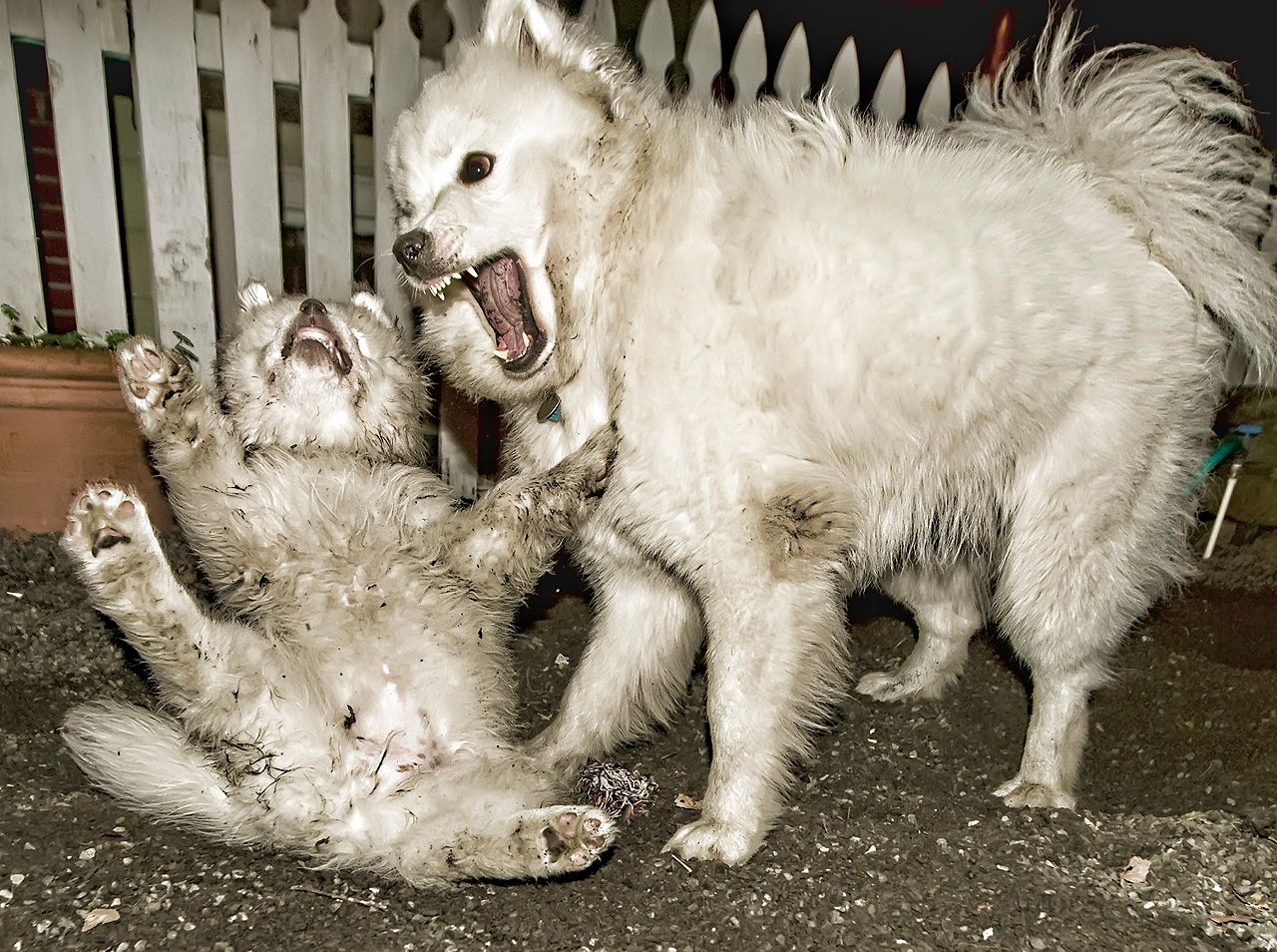
He’s usually very interested in what we’re saying, although he’s not “obedient” in the classic sense. What I mean is this: when he’s being a total maniac and bouncing off the walls, I can say his name firmly but softly, and he will stop, cock his head and stare at me to try to figure out what I’m communicating. This is very useful at times, and he’s been that way from a very early age. Alice, on the other hand … no way.
Somebody recently asked on his page whether he really herds Alice away from the cats when she’s annoying them, and he really does. I’ve never seen a dog do this, but he does it every time she gets in the cats’ faces – usually he straddles her and tries to contain her with his front paws and turn her away from the sharp cat claws. It’s extremely cute to see in action.
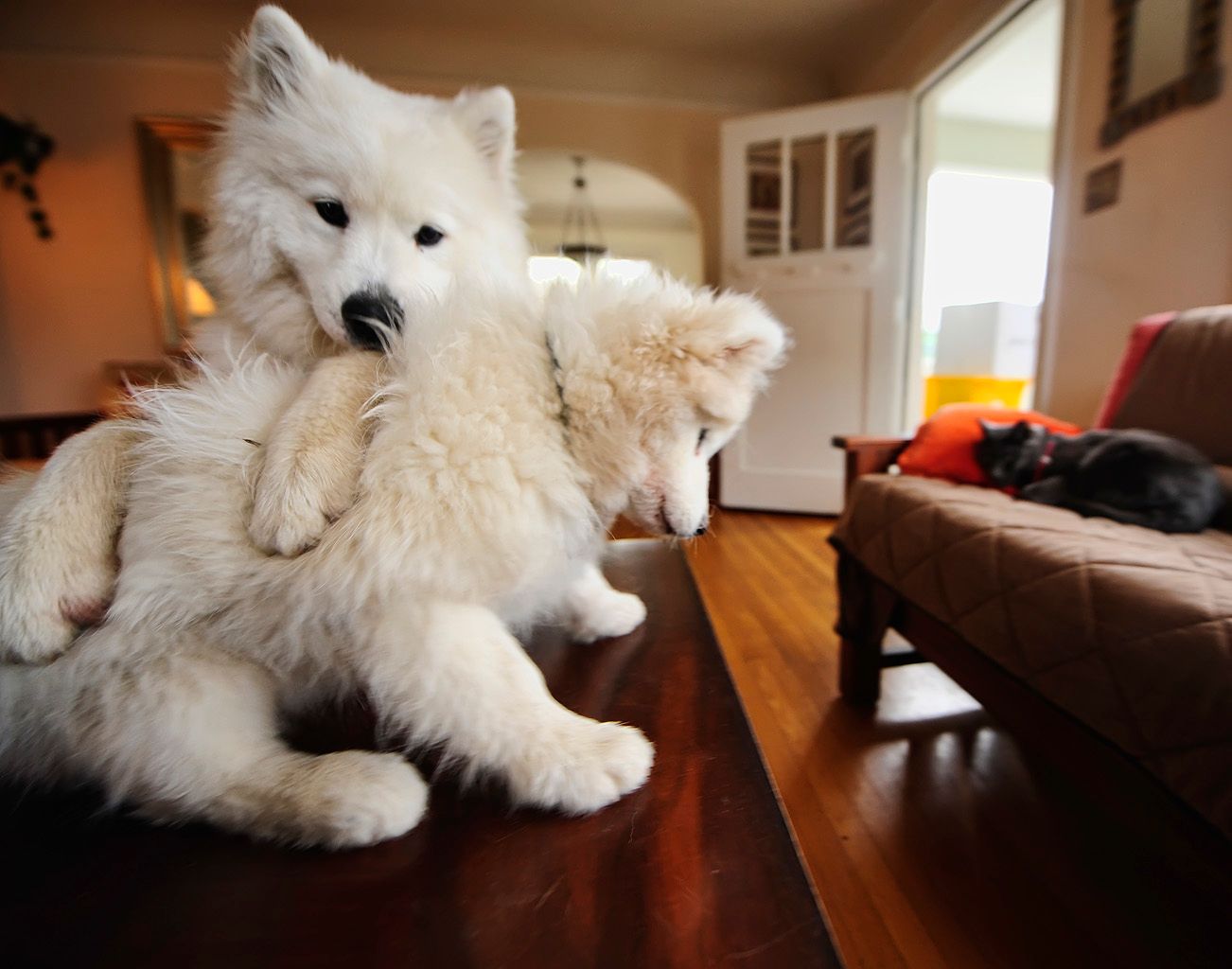
Megan treated Jamie like a kitten from an early age, carrying him around and picking him up all the time, and I’ve done the same. As a result, he has absolutely no reaction to being picked up, and doesn’t see that as unusual or a problem at all. We’re raising Alice the same way. Yesterday at Christmas dinner, the small kids carried Alice around constantly, and she never complained at all (although she started hiding under my chair later in the evening).
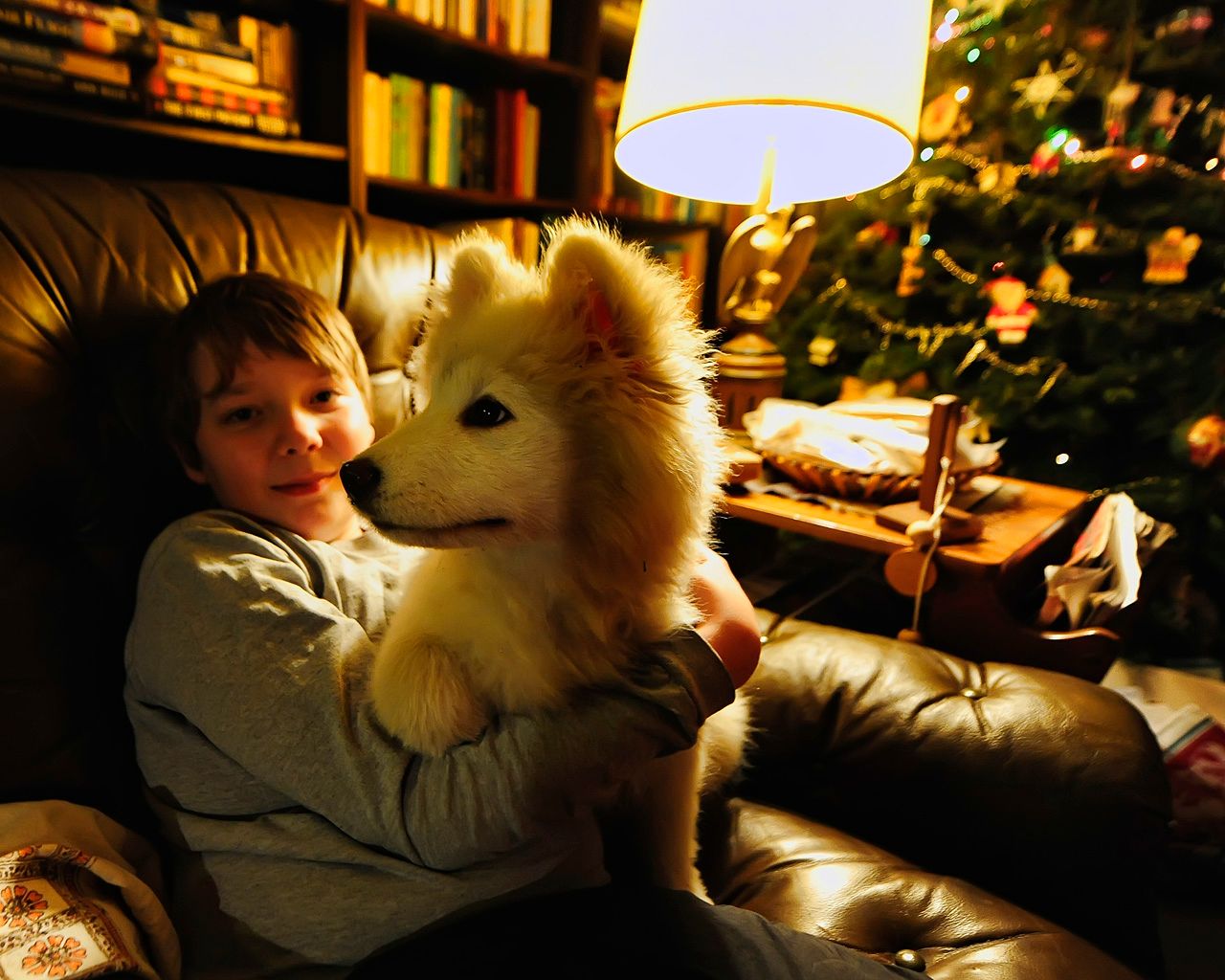
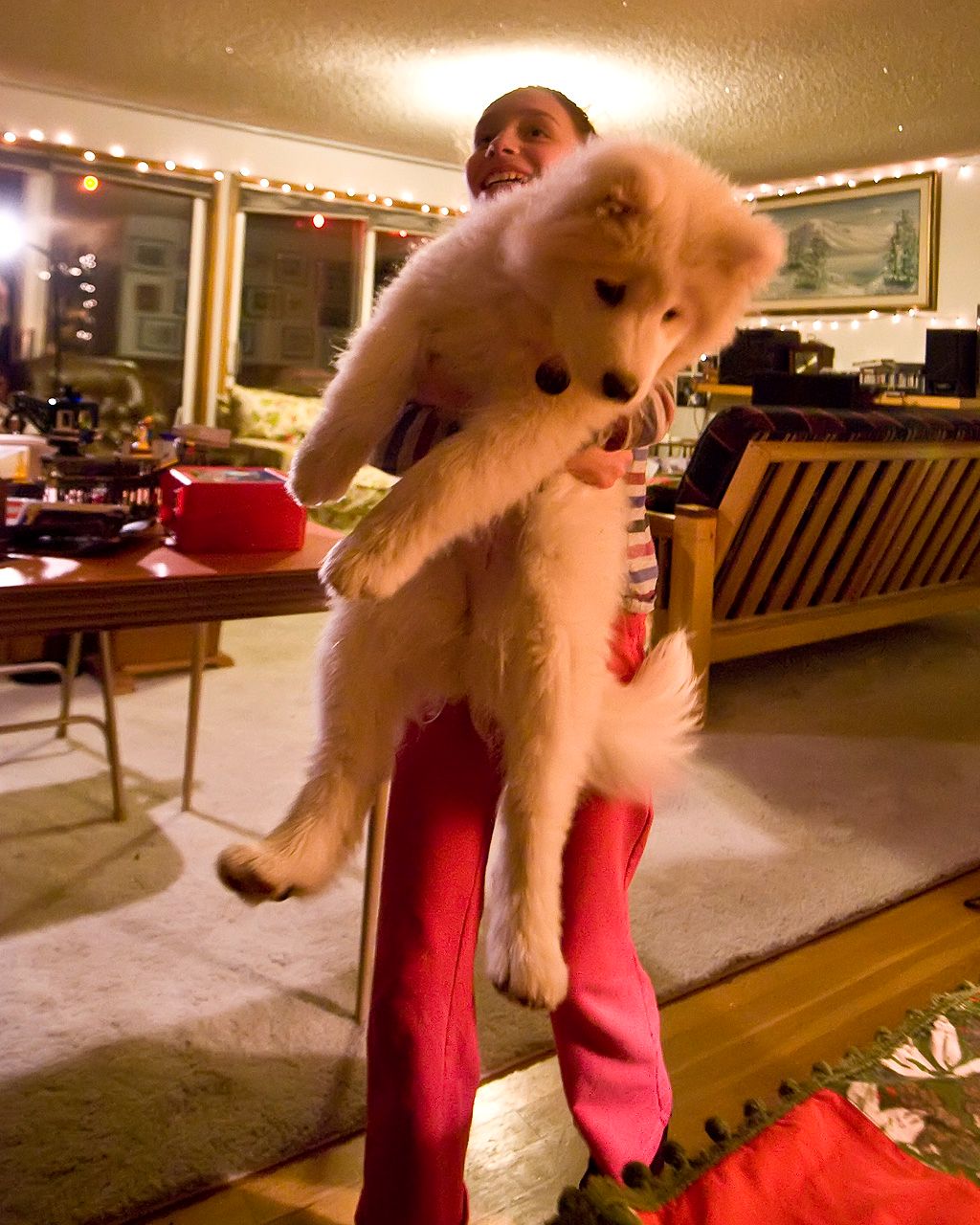
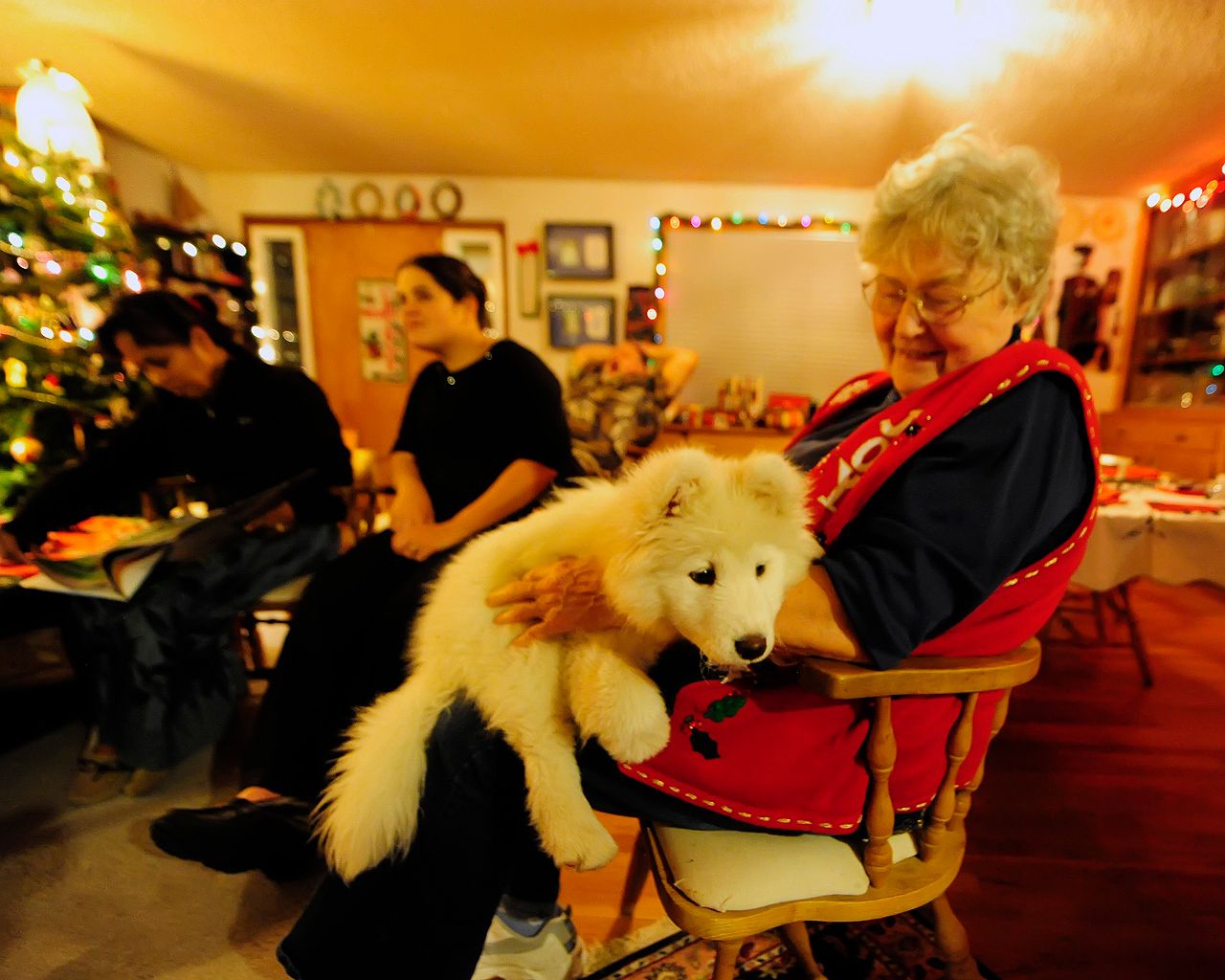
Jamie has a quirk that I probably taught him: play growling. He does this fake sort of growling when he plays, a grr-grr-grr sound that’s at least an octave above his actual growl. He seems to think this is something you do to convey that you’re just playing. Alice doesn’t do this, but then she’s often fighting with all her might against a much larger dog (something Jamie has rarely experienced), so playtime isn’t all fun and games for her.
He has traveled in the car nearly every day of his life (usually multiple times each day), and is calmer in that situation than any dog I’ve known. He has only had his nose out the window a handful of times, and only at low speeds, so he has no interest in that – you can roll the window down while he’s sitting next to it on the freeway, and he’ll just watch out the open window without sticking his nose out. When we walk out the door and head for the car or truck, he always stops to do his business (to be ready for the ride), and he usually lays down immediately upon getting in the car, unless he has reason to believe we’re going somewhere exciting, in which case he sits up alert and eager, silently waiting for what’s to come. This is another trait that Alice is coming to share: they are great travel companions.
Contrary to what one might expect, Jamie is the main source of puppy playfulness in their relationship, despite Alice being much younger. He’s usually the first one to suggest playing with a toy, the first one to pounce like a silly kitten, and so on. Alice looks like she will be in charge some day (being the more aggressive and assertive of the two), but it looks like Jamie will always be the one setting the playful goofball tone that we love in them.
Finally, Jamie wants the pack together at all times. I’ve never had a dog that exhibits this to the degree that he does. When we’re out for a walk, Megan and I can never stray more than 20 feet apart without Jamie trying to correct the situation. When the dogs are playing in the yard, Alice will often run inside on her own, but it’s very difficult to get Jamie to come inside when Alice is still outside. The one exception is at night: Jamie will sometimes lay downstairs in the living room while the rest of us are upstairs. But I think that’s because he knows there’s only one way we ever come down (the stairs), so as long as he’s near the stairs the pack can’t get split up. If we occasionally climbed out the window to exit the bedroom, I think he’d be less inclined to leave the pack there without keeping a close eye on us.
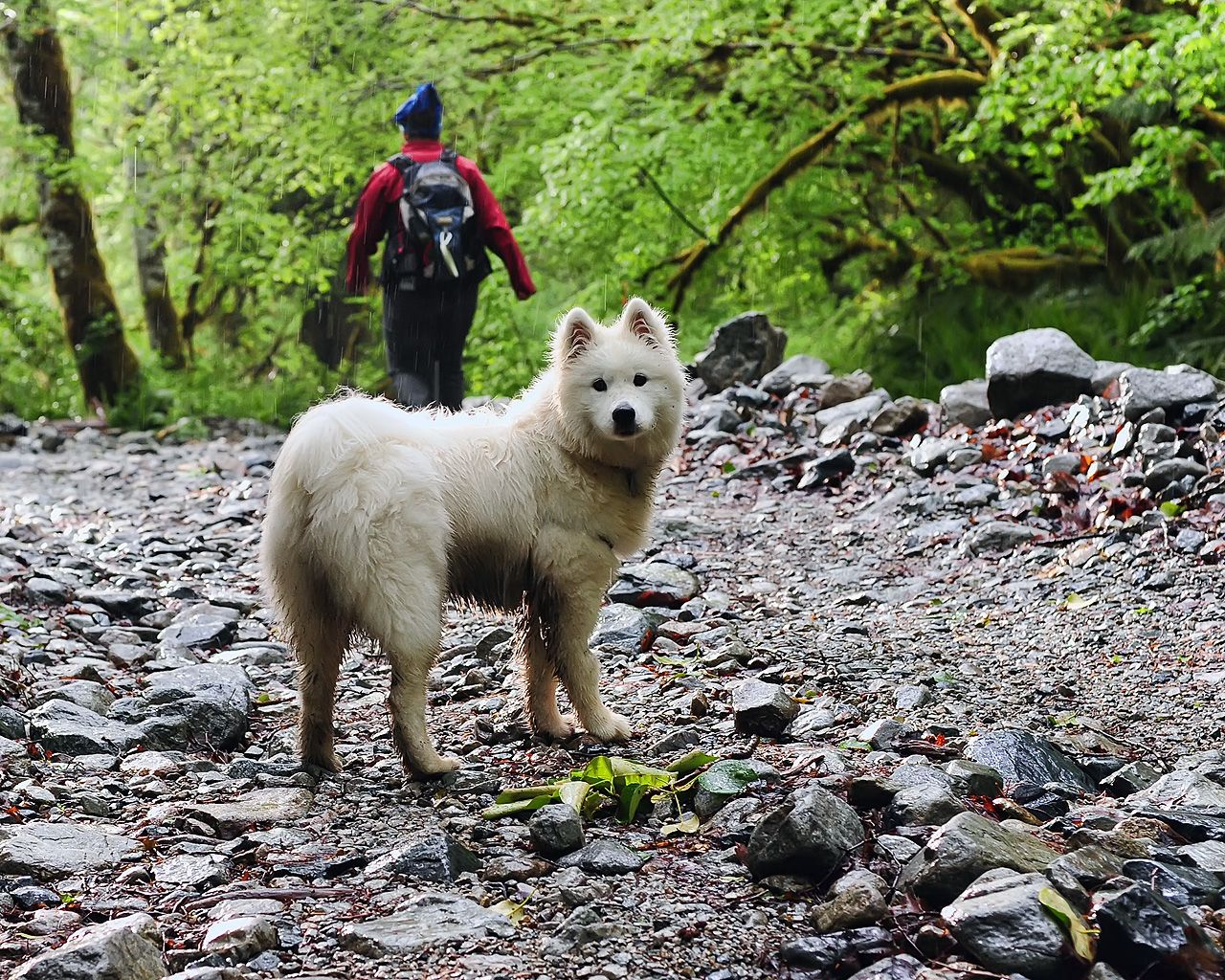
Training
For many people, training a dog to understand specific words is one of the most important or satisfying or interesting things one can do with a dog. In the understatement of the month, I’ll just say that we’re not among those people. I’ve had seven dogs of my own now, and it’s clear that I can have a ton of fun with a dog (and I think they enjoy it quite a bit, too) without the dog knowing any particular English words. If they know who’s in charge, that’s enough for me.
We do things every day to remind Jamie and Alice who’s in charge. For example, we take their food (or bones) away when they’re half done, then give them back after a while. And we never repeat commands – if we call them in from the yard and they don’t come after the first call, we go get them and physically bring them in. Over time, this has resulted in them accepting their place, and both Jamie and Alice consistently exhibit all the tell-tale signs of understanding the pack hierarchy. They wait at the top of the stairs (or inside the front door) for us to take the first step, they never paw at us while we’re eating (although they’re quite aggressive when they want to play), and so on.
The only other thing that I take as seriously with dogs as “who’s in charge” is the concept of not being afraid of other people and dogs. I think dogs can learn that from their owners, just as dogs can learn that strangers (or loud noises, or vicious dogs) are scary. I don’t believe that I’ve ever gasped or yelled in surprise or horror in front of Jamie or Alice, and I hope I never do. They are both so calm about things that scare some dogs: as one of many examples, we can walk them past loud aggressive dogs who are snarling and snapping and carrying on, and our dogs don’t react at all – they don’t cower in fear, and they don’t bark loudly and ferociously in fear, either. I am very proud of them at moments like that.
Sled dogs are smart, but they don’t have that desire to please authority figures that is so common in some other breeds. I once had a book that covered all 125 AKC breeds, and for each breed they had a ranking from 1-5 on problem-solving intelligence, and a separate 1-5 ranking on obedience/training aptitude. A few breeds, such as German Shepherds, Labrador Retrievers and Poodles, had the highest possible ranking in both of those categories; Malamutes, on the other hand, had the distinction of being the only breed with a 5 for problem-solving and a 1 for obedience. Most sled-dog breeds share those tendencies. (I once showed my Mom that book, and she said “it’s no surprise that you like Malamutes so much.”)
There’s an anecdote in one of Susan Conant’s books (which prominently feature Malamutes) that I had it on the home page of my web site for a while in the late 90s. I have no illusion that I’ll ever be in a life-or-death situation with my dogs, but the general attitude of this story is something I agree with:
A young man asked a seasoned musher, “wouldn’t it be easier on everybody if the northern breeds were more obedient?” The musher answered carefully. “Well, there are times that would be nice. But when I’m about to head across a frozen lake deep in the woods, all alone and many miles from the nearest person or shelter, my priorities are a little different. At that moment, if any member of my dog team senses a microscopic tremor in the ice that might mean it isn’t safe, I want that dog to speak up. I want to stop and argue about it.”
When I’m trying to get Jamie to walk with me, and he’s trying to pull in some other direction, I’m more inclined to be curious about what he’s thinking than to be concerned with “correcting” anything.
Being a Social-Media Dog
We post several times a day on Jamie’s page, and that probably adds an hour or so to the time we already spend every day on dog-related chores: walking them, feeding them, taking pictures of them, playing with them, sitting around gazing at them, and all the rest. We both have full-time jobs, but we’ve found ways to fit in these posts by employing a variety of tactics:
- We take them to work some days, and they sleep in our vehicles. They’re never in the car for more than a couple of hours straight, and we often hand them off to one another at noon or between meetings.
- We sometimes take pictures in the morning before work and then post some of them later in the day, to break up the long stretches when we’re too busy to be taking pictures. We’ve never crossed the line into posting pictures on a different date than when they were taken; at the rate they’re growing and changing still, that might look strange.
- We make the dogs part of everything we do, and that creates many photo opportunities. A simple trip to the grocery store or gas station can result in the best photo of the day sometimes.
- We use our cell phones to post photos whenever possible, and that makes it easy to get a quick shot and post it without really taking any time out of the day.
A few things have fallen by the wayside, due to all the time this takes. I’ve nearly stopped posting on Twitter, for example. And there are things people have asked us to do that we never get around to, such as posting videos. Everyone has their interests, and I must admit that “motion pictures” really don’t interest me very much. For example, I’ve flown more than anyone I know in recent years, and I’ve never gotten around to watching a movie on a flight; maybe someday. So the concept of spending time recording and uploading videos just doesn’t appeal to me much.
There’s some irony in the fact that spending so much time with our dogs, and representing them via social media, has significantly reduced our available time for socializing with humans. We see this as a positive side effect, actually – the things we do with the dogs are generally much healthier and less expensive than the things we do with humans.
There are some aspects to Jamie’s online voice/persona that we’ve settled on:
We try to stick to what the dogs actually experience each day. So the photos are usually from their eye level, and Jamie never mentions news or politics or how bad the traffic was, or other things that only humans care about.
We’ve stopped trying to answer questions that are clearly directed at us, since we can’t speak as ourselves and also because we don’t think Jamie’s followers are interested in watching us humans have discussions with other humans about human topics such as “how to raise a dog.”
At first, when Jamie was just on Twitter, we referred to ourselves by our Twitter handles (dmahugh and ikofish). But that’s not consistent with this being Jamie’s voice – a dog surely wouldn’t know that sort of trivia. So we’ve moved to using “Mom” and “Dad” consistently instead. I’ve been amused to learn that some people think that means we’re anthropomorphizing the dogs into human children or something. But more accurate terms like “alpha male” and “alpha female” are too clumsy, so we’re sticking to Mom and Dad.
We try to accurately convey Jamie’s whimsical carefree attitude, such as his utter lack of concern when he makes Alice scream, or when he (or she) is near some sort of danger. In keeping with our goal of helping the dogs learn to live without fear, we certainly don’t want to correct that attitude.
We don’t cover potentially disturbing things that happen, or might happen. For example, Alice recently swallowed a 2-inch bone which fell out of a pack of larger bones. We were very concerned, and never let her out of our sight until she threw up the bone the next day (rather smaller due to being broken down by her stomach acids – she’s a tough dog!). And Jamie was so cool, not pestering her at all while she was acting a little different from usual. But we didn’t say a word about it on his page, because we know that many people have developed a strong sense of caring for our dogs, and we don’t want to upset them needlessly or add negatives to his page. Sure, we’d cover it accurately if something bad were to really happen to one of the dogs, but it has to actually happen first.
When it comes to the captions, we try to write things that he might actually think and stay “in voice.” That usually means including at least one exclamation point in every post, because Jamie’s usually excited!
Megan’s much better about sticking to Jamie’s voice than I am. If you see Jamie say something that sounds out of character, I probably wrote that one.
Jamie Turn Pro? Never!
From time to time, we’ve been the lucky recipients of insightful advice about how to drive more traffic to Jamie’s page, how to get more followers, and so on. It seems that many people can’t imagine spending time an online activity that isn’t headed toward some sort of get-rich-quick scheme, or at least a get-famous-online scheme.
But we’re doing this for fun, not profit, and it’s extremely unlikely that another person – especially one who doesn’t spend hours each day posting photos of their dog – could ever dream up some new approach that would be more fun to us than what we choose to do on our own. We have a great group of people following Jamie online, many of whom clearly love him like a dog of their own. Jamie just passed 200 followers on Facebook, and I have no desire to manage that number or proactively work to increase it.
And truthfully, Jamie already has so many followers that it’s a bit of a burden to live up to the expectations we’ve created. One two recent occasions, we didn’t post a photo for most of the day, and people posted comments of concern about how whether the dogs were OK, or comments about how much they missed them. I understand those feelings, and I feel some responsibility for satisfying them, but I don’t think I’d ever want to have an order of magnitude more people following our pups. We’re busy enough just keeping up with what we’ve started.
We’re very grateful for all of the people who participate in the fun of having wonderful dogs like Jamie and Alice. Their followers include people who have experience with Samoyeds, people who do great work with animal rescue operations of various kinds, people who just plain love dogs, and many others. Thanks to all of you who give me and Megan fun surprises every day with your comments. It’s great to feel like our dogs have a huge diverse worldwide pack.
OK, enough rambling as “Doug.” Time to get back to being Jamie!
